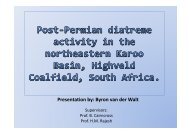Geology & Geophysics Guide to Borehole Core in the Karoo Basin ...
Geology & Geophysics Guide to Borehole Core in the Karoo Basin ...
Geology & Geophysics Guide to Borehole Core in the Karoo Basin ...
Create successful ePaper yourself
Turn your PDF publications into a flip-book with our unique Google optimized e-Paper software.
<strong>Geology</strong> & <strong>Geophysics</strong><br />
<strong>Guide</strong> <strong>to</strong> <strong>Borehole</strong> <strong>Core</strong><br />
<strong>in</strong> <strong>the</strong> <strong>Karoo</strong> Bas<strong>in</strong> Coalfields<br />
South Africa<br />
(<strong>in</strong>terim report)<br />
Bruce Cairncross (PhD)<br />
Head: Department of <strong>Geology</strong><br />
University of Johannesburg
Wh Why? ?<br />
Provide a colour pho<strong>to</strong>graphic guide of typical<br />
borehole core samples from <strong>the</strong> <strong>Karoo</strong> Bas<strong>in</strong><br />
coalfields <strong>to</strong>:<br />
:<br />
- Standardize descriptions when logg<strong>in</strong>g core<br />
- Assist geologists, geotechnicians, drillers,<br />
samplers samplers, etc <strong>in</strong> recognis<strong>in</strong>g common features<br />
such as rock type and sedimentary structures<br />
<strong>in</strong> borehole core.
Cross-bedded sands<strong>to</strong>ne<br />
Matrix-supported conglomerate
Bioturbated silts<strong>to</strong>ne/sands<strong>to</strong>ne<br />
(50 core samples pho<strong>to</strong>graphed <strong>to</strong>-date) <strong>to</strong> date)
Eng<strong>in</strong>eer<strong>in</strong>g <strong>Geology</strong> 64 (2002) 19–39<br />
“A geomechanical survey of some different facies <strong>in</strong> relation <strong>to</strong><br />
stability at a m<strong>in</strong>e <strong>in</strong> <strong>the</strong> Eastern Transvaal Coalfield, South Africa”<br />
F.G. Bell*, C.A. Jermy<br />
DDepartment t t of f <strong>Geology</strong> G l and dA Applied li d G<strong>Geology</strong>, l<br />
University of Natal, Durban, 4041, South Africa<br />
“In particular, poor roof and floor conditions were found <strong>to</strong> be<br />
associated with rocks of <strong>the</strong> argillaceous facies. The most<br />
stable t bl strata t t were <strong>the</strong> th f<strong>in</strong>e-gra<strong>in</strong>ed fi i d arenaceous facies f i whilst hil t<br />
those of <strong>the</strong> coarse-gra<strong>in</strong>ed facies were somewhat less<br />
stable”.
Poor roof / floor<br />
conditions<br />
di i
Stable roof / floor conditions
Interstate highway road-cut,<br />
KKentucky, t k USA USA(A (Appalachian l hi coalfields) lfi ld )<br />
Flat bedded sands<strong>to</strong>ne with <strong>in</strong>terlayered silts<strong>to</strong>ne
Carboniferous coalfields, Alabama, USA
Record<strong>in</strong>g Gra<strong>in</strong> size <strong>in</strong> Sedimentary Rocks<br />
Üdden‐Wentworth Clastic Sediment Gra<strong>in</strong>‐size Chart<br />
mm diameter Name<br />
(above 256) Boulders<br />
256<br />
128<br />
Cobbles<br />
64<br />
Gravel<br />
32<br />
16<br />
(rock equivalent = conglomerate)<br />
8<br />
4<br />
Pebbles<br />
2 Granules Granules<strong>to</strong>ne (“grits<strong>to</strong>ne”)<br />
1 Very coarse sand<br />
0.5 Coarse sand<br />
0.25 Medium sand<br />
0.125 F<strong>in</strong>e sand<br />
0.063 Very f<strong>in</strong>e sand<br />
00.031 031 Coarse silt<br />
0.0156 Medium silt<br />
0.0078 F<strong>in</strong>e silt<br />
00.0039 0039 Very f<strong>in</strong>e silt<br />
(less than 0.0039) Clay<br />
Sand<br />
(rock equivalent = sands<strong>to</strong>ne)<br />
Mud<br />
(rock equivalent = muds<strong>to</strong>ne;<br />
<strong>in</strong>cludes silts<strong>to</strong>ne and shale)
The borehole core samples illustrated here are<br />
colour coded for easy reference:<br />
GREY = Muds<strong>to</strong>ne (<strong>in</strong>clud<strong>in</strong>g shale and<br />
silts<strong>to</strong>ne)<br />
RED = <strong>in</strong>terlayered muds<strong>to</strong>ne<br />
and sands<strong>to</strong>ne<br />
YELLOW = Sands<strong>to</strong>ne<br />
BLUE = conglomerate<br />
GREEN = deformed strata<br />
PURPLE PURP = igneous rocks (dolerite)
Academic / Scientific Reasons for a standardized core log book<br />
Interpret<strong>in</strong>g <strong>the</strong> environments of formation of <strong>the</strong> rocks conta<strong>in</strong><strong>in</strong>g <strong>the</strong><br />
p g g<br />
coal (different coal types and coal distributionsassociated with different<br />
depositional environments)
Mississippi Delta (River (River-dom<strong>in</strong>ated dom<strong>in</strong>ated delta)
Bedload Fluvial<br />
Facies Assemblage g
<strong>Borehole</strong> <strong>Core</strong> Supplied by<br />
Project Sponsored by




